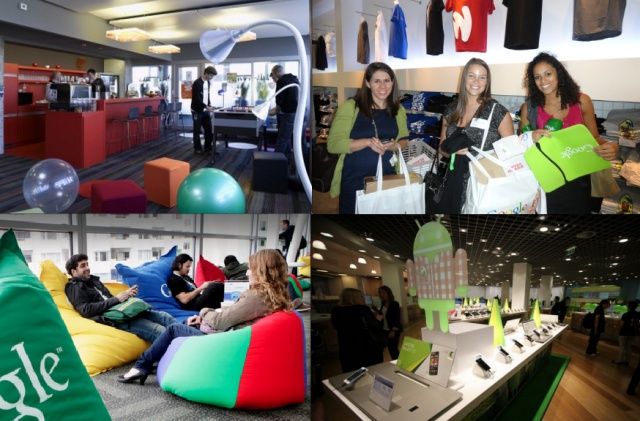How Google Stores Could Transform Google
The site 9to5Google reported this week that an “extremely reliable source” says Google plans to open retail stores later this year.
The purpose of the stores, according to the post, is to sell Google products like the Nexus line of phones and tablets, and also to promote hard-to-understand future items like the Google Glass idea.
The author speculated that Google might also sell Google merchandise like T-shirts.
All this sounds like either crazy talk, or the kind of Apple envy that may have motivated Microsoft to open a chain of retail stores.
But I think Google Stores could be a huge advantage for Google.
Apple Stores are profitable in part because the company sells a small number of highly profitable products. One sale of, say, an iPhone, iPad or MacBook Pro nets Apple not a few dollars, but as many as a few hundred dollars. After a few hundred such purchases, it begins to add up.
Apple Stores also benefit the company as a constant branding effort.
Google, on the other hand sells advertising as its main source of revenue. So how could a big retail presence help Google?
In a nutshell, by communicating difficult-to-understand Google products, services and initiatives.
Apple Stores didn’t use to have that role, because Apple’s products were easy to understand. For example, an iMac or an iPhone is pretty straightforward, and people get it.
But then the iPad came along three years ago, and Apple discovered the third benefit of retail stores.
When Apple first launched the iPad, Apple’s retail stores helped Apple answer the “what’s it for?” question, according to CEO Tim Cook.
What he means is that there is a certain class of product or technology where a mere description can’t convey it’s appeal or value.
When you describe the iPad, it sounds like a terrible product. “Uh, it’s like a laptop without a keyboard and without any processing power and without the ability to run the applications that run on your desktop computer.” That’s a tough sell.
But when you try an iPad, the experience is like: “Wheeeee! I’ve gotta have one!”
Thanks to Apple’s retail stores, the iPad is a hit and everybody gets it now.
So Apple uses its retail presence for three purposes: Sales, branding and to enable potential users to experience products that can’t be appreciated otherwise.
While Apple had or has one “what’s it for?” product, Google has dozens.
For example: Google+, Google Now and the Knowledge Graph, Google Goggles, Google Voice, Google Local, Google Latitude, the Events feature of Google+ and — perhaps most urgently — Google TV.
We geeks get all this stuff. But most of these products and services barely register in the minds of most consumers and, even if they’ve heard about them, don’t understand their value. As a result, all these Google goodies don’t have the interest, mindshare or adoption that they should.
By showcasing all this stuff at a Google Store, Google could set this right.
In addition to actual Google products, Google struggles to inspire behaviors and desires in the minds of consumers that benefit the future that Google desires.
One example is the desire and expectation for high-bandwidth Internet connectivity. Carriers and Internet providers in the US provide over-priced, under-powered connectivity, an have convinced consumers to accept it as normal.
In Google’s ideal world, everyone would have vastly higher-bandwidth pipes, enabling powerful cloud-computing apps, more photo and video sharing and more online everything.
To stimulate demand for higher bandwidth connections, Google spent a lot of money wiring Kansas City with ultra high-speed fiber. But for the vast majority of Google customers, who have never been to Kansas City, the idea remains an abstraction.
By wiring all their Google Stores with fiber connections and letting anyone use it for free, Google could make us all appropriately dissatisfied with our existing Internet connections. Over time, the public would be less accepting of slow connections, and demand much higher bandwidth. Even better, Google could implant the idea that fiber to the device is what enables fast connections, and get us all to demand fiber to the home from our governments and Internet providers.
They could even serve coffee, and Android-themed desserts like ice cream sandwiches and slices of key lime pie.
I can imagine Google Stores as a kind of cross between an Apple Store, a Starbucks and Google I/O — a playground for everybody where Google showcases its marvels, and lets people experience the future as Google envisions it.
The Google Store could be furnished with Googly furniture like beanbag chairs and little tables where Android devices of every description, as well as Chromebooks and other gadgets are lashed to the tables and connected to the Internet with blistering-fast connections.
I can imagine giant-screens showing live hangouts: When the president or astronauts or Conan O’Brien are doing hangouts, those would be live on screen. When no high-visibility hangouts are scheduled, Google could hook up various stores together into an ambient hangout.
A play area for kids could offer a tiny table with Android tablets showcasing children’s books and apps.
The stores should offer fast free Wi-Fi, so that even if the stores were packed and every beanbag taken, there would be a generalized mob surrounding the entrance to the store, showing the world every day that everybody wants what Google’s got.
Google Stores could serve the same purpose for users that Google I/O does for developers, encouraging education, networking, information and, above all, brand excitement and loyalty.
Google needs users to keep up with where Google is going, and to acquire the knowledge, skills, desires and behaviors that Google needs users to have if the company is to move everything forward.
In a nutshell, the reason Google needs Google Stores is that in addition to building a better Internet, Google needs to build a better user.



